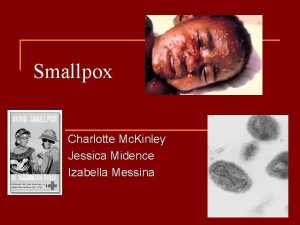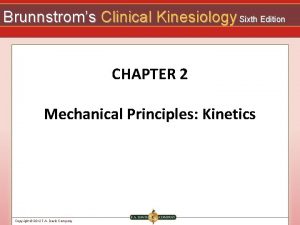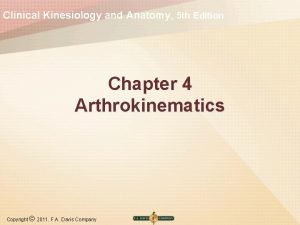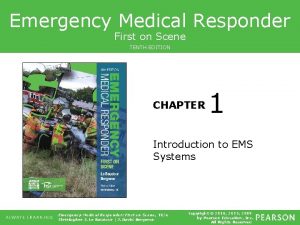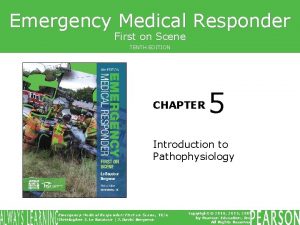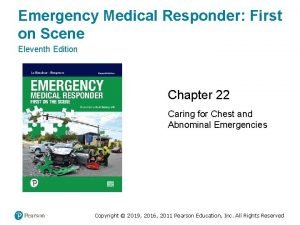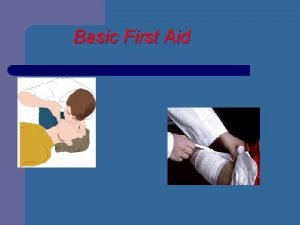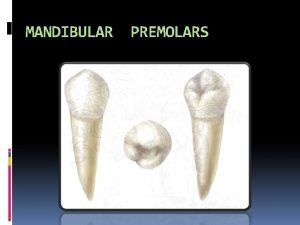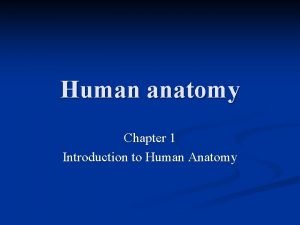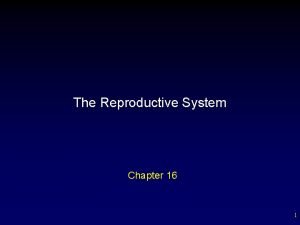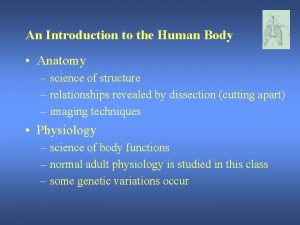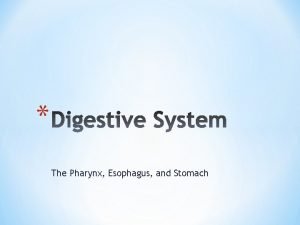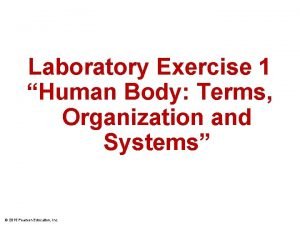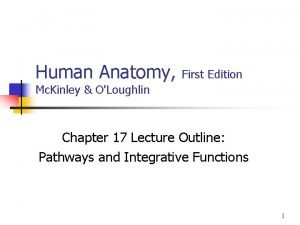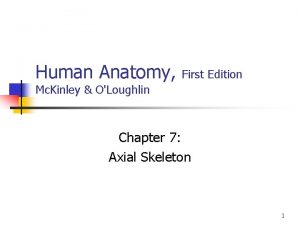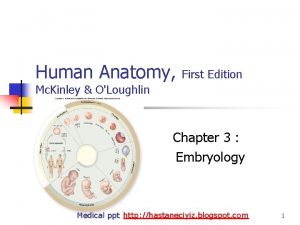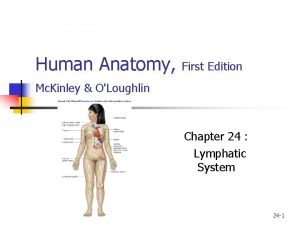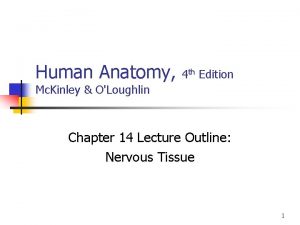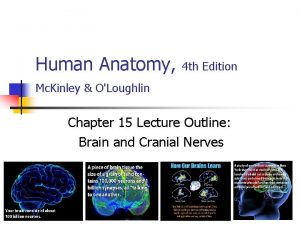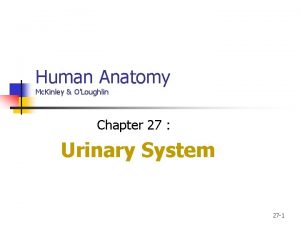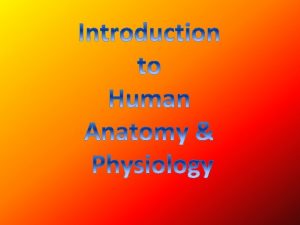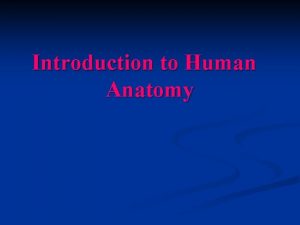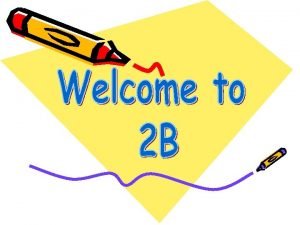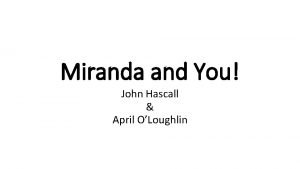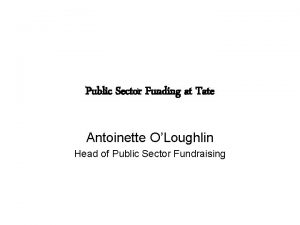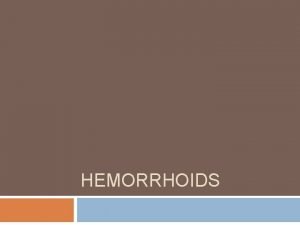Human Anatomy First Edition Mc Kinley OLoughlin Chapter








































- Slides: 40

Human Anatomy, First Edition Mc. Kinley & O'Loughlin Chapter 20 Lecture Outline: Endocrine System 1

Endocrine System n n n Endocrine system and the nervous system often work together to bring about homeostasis. Both use specific communication methods and affect specific target organs. Their methods and effects differ. 20 -2

3

Endocrine Glands & Hormones n n n Exocrine glands n secretions released into ducts opening onto an epithelial surface Endocrine glands n ductless organs that secrete their molecules directly into the bloodstream All endocrine cells are located within highly vascularized areas to ensure that their products enter the bloodstream immediately. 20 -4

Overview of Hormones n n Molecules that have an effect on specific organs. Only cells with specific receptors for the hormone respond to that hormone. Called target cells, and the organs that contain them are called target organs. Organs, tissues, or cells lacking the specific receptor do not respond to its stimulating effects. 20 -5

Classification of Hormones n Peptide hormones n n n Steroid hormones n n n formed from chains of amino acids most of our body’s hormones are peptide hormones longer chains are called protein hormones example is growth hormone type of lipid derived from cholesterol example is testosterone Biogenic amines n n small molecules produced by altering the structure of a specific amino acid example is thyroid hormone 20 -6

Negative Feedback Loop n n A stimulus starts a process, and eventually either the hormone that is secreted or a product of its effects causes the process to slow down or turn off. Many hormonal systems work by negative feedback mechanisms. n one example is the regulation of the blood glucose level in the body 20 -7

8

Positive Feedback Loop n n Accelerates the original process, either to ensure that the pathway continues to run or to speed up its activities. Only a few positive feedback loops occur in the human endocrine system. n one example is the process of milk release from the mammary glands 20 -9

10

Hypothalamic Control of the Endocrine System n As the master control center of the endocrine system the hypothalamus oversees most endocrine activity. n special cells in the hypothalamus secrete hormones that influence the secretory activity of the anterior pituitary gland n n called regulatory hormones because they are secreted into the blood to regulate secretion of most anterior pituitary hormones releasing hormones (RH) inhibiting hormones (IH) Hypothalamus has indirect control over these endocrine organs. 20 -11

Hypothalamic Control of the Endocrine System n Hypothalamus produces two hormones that are transported to and stored in the posterior pituitary. n n n Hypothalamus directly oversees the stimulation and hormone secretion of the adrenal medulla. n n oxytocin antidiuretic hormone (ADH) An endocrine structure that secretes its hormones in response to stimulation by the sympathetic nervous system. Some endocrine cells are not under direct control of hypothalamus. 20 -12

13

Pituitary Gland (Hypophysis) n n n lies inferior to the hypothalamus. Small, slightly oval gland housed within the hypophyseal fossa of the sphenoid bone. Covered superiorly by the diaphragma sellae, which is one of the cranial dural septa that ensheathes the stalk of the infundibulum to restrict pituitary gland movement. Connected to the hypothalamus by a thin stalk, the infundibulum. Partitioned both structurally and functionally into an anterior pituitary and a posterior pituitary. n (called anterior lobes and posterior lobes) 20 -14

15

Control of Anterior Pituitary Gland Secretions n n Anterior pituitary gland is controlled by regulatory hormones secreted by the hypothalamus. Hormones reach the anterior pituitary via hypothalamohypophyseal portal system. n essentially a “shunt” that takes venous blood carrying regulatory hormones from the hypothalamus directly to the anterior pituitary before the blood returns to the heart 20 -16

17

18

Thyroid Gland n n Located immediately inferior to the thyroid cartilage of the larynx and anterior to the trachea. Distinctive “butterfly” shape due to its left and right lobes, which are connected at the anterior midline by a narrow isthmus. Both lobes of the thyroid gland are highly vascularized, giving it an intense reddish coloration. Regulation of thyroid hormone secretion depends upon a complex thyroid gland–pituitary gland negative feedback process. 20 -19

20

21

22

Parathyroid Glands n n n Small, brownish-red glands located on the posterior surface of the thyroid gland. Usually four small nodules, but some individuals may have as few as two or as many as six. Two different types of cells in the parathyroid gland: n n n chief cells and oxyphil cells The chief cells are the source of parathyroid hormone (PTH). n stimulates osteoclasts to resorb bone and release calcium ions from bone matrix into the bloodstream n stimulates calcitriol hormone synthesis in the kidney n promotes calcium absorption in the small intestine n prevents the loss of calcium ions during the formation of urine The function of oxyphil cells is not known. 20 -23

24

25

26

Adrenal Glands (suprarenal) n n n Paired, pyramid-shaped endocrine glands anchored on the superior surface of each kidney. Retroperitoneal and embedded in fat and fascia to minimize their movement. Outer adrenal cortex and an inner central core called the adrenal medulla. n secrete different types of hormones 20 -27

Adrenal Cortex n n Distinctive yellow color due to stored lipids in its cell. Synthesize more than 25 different steroid hormones, collectively called corticosteroids. n n n corticosteroid synthesis is stimulated by the ACTH produced by the anterior pituitary corticosteroids are vital to our survival; trauma to or removal of the adrenal glands requires corticosteroid supplementation throughout life Partitioned into the zona glomerulosa, the zona fasciculata, and the zona reticularis. Different functional categories of steroid hormones are synthesized and secreted in the separate zones. Regulates salt, sugar, and sex! 20 -28

29

30

31

Adrenal Medulla n n n Forms the inner core of each adrenal gland. Pronounced red-brown color due to its extensive vascularization. Primarily consists of clusters of large, spherical cells called chromaffin cells. When innervated by the sympathetic division of the ANS, one population of cells secretes the hormone epinephrine (adrenaline). The other population secretes the hormone norepinephrine (noradrenaline). Hormones work with the sympathetic nervous system to prepare the body for an emergency or fight-or-flight situation. 20 -32

Pancreas n n n Elongated, spongy, nodular organ situated between the duodenum of the small intestine and the spleen and posterior to the stomach. Both exocrine and endocrine activities, and thus it is considered a heterocrine (mixed) gland. Mostly composed of cells called pancreatic acini. n n produce an alkaline pancreatic juice that aids digestion Scattered among the pancreatic acini are small clusters of endocrine cells called pancreatic islets (islets of Langerhans) composed of four types of cells: n n n two major types (called alpha cells and beta cells) two minor types (called delta cells and F cells) each type produces its own hormone 20 -33

Pancreas n n n Alpha cells secrete glucagon when blood glucose levels drop. Beta cells secrete insulin when blood glucose levels are elevated. Delta cells are stimulated by high levels of nutrients in the bloodstream. n n n synthesize somatostatin, also described as growth hormone-inhibiting hormone, or GHIH, which slows the release of insulin and glucagon and slows the rate of nutrient entry into the bloodstream F cells are stimulated by protein digestion. n secrete pancreatic polypeptide to suppress and regulate somatostatin secretion from delta cells Pancreatic hormones provide for orderly uptake and processing of nutrients. 20 -34

35

36

Pineal Gland n n Pineal gland or pineal body, is a small, cone-shaped structure attached to the posterior region of the epithalamus. Secretes melatonin. n helps regulate a circadian rhythm (24 -hour body clock) n also appears to affect the synthesis of the hypothalamic regulatory hormone responsible for FSH and LH synthesis n role in sexual maturation is not well understood 20 -37

Thymus n n A bilobed structure located within the mediastinum superior to the heart and immediately posterior to the sternum. Size of the thymus varies between individuals. n it is always relatively large in infants and children n as with the pineal gland, the thymus diminishes in size and activity with age, especially after puberty Functions principally in association with the lymphatic system to regulate and maintain body immunity. Produces complementary hormones thymopoietin and thymosins. n hormones act by stimulating and promoting the differentiation, growth, and maturation of a category of lymphocytes called T-lymphocytes (thymus-derived lymphocytes) 20 -38

Endocrine Functions of the Kidneys, Heart, GI Tract, and Gonads n Organs of the urinary, cardiovascular, digestive, and reproductive systems contain their own endocrine cells, which secrete their own hormones. n n help regulate electrolyte levels in the blood red blood cell production, blood volume, and blood pressure digestive system activities sexual maturation and activity 20 -39

Aging and the Endocrine System n n n Secretory activity of endocrine glands wanes, especially secretion of growth hormone and sex hormones. Reduction in GH levels leads to loss of weight and body mass. Testosterone or estrogen levels decline 20 -40
 Dr kinley berger
Dr kinley berger El vial de kinley
El vial de kinley Human anatomy and physiology seventh edition marieb
Human anatomy and physiology seventh edition marieb Human anatomy and physiology 10th edition
Human anatomy and physiology 10th edition Anatomy and physiology ninth edition
Anatomy and physiology ninth edition Human anatomy fifth edition
Human anatomy fifth edition Human anatomy fifth edition
Human anatomy fifth edition Adler and rodman 2006
Adler and rodman 2006 Waistline
Waistline Chapter 1 introduction to human anatomy and physiology
Chapter 1 introduction to human anatomy and physiology Chapter 2 human reproductive anatomy and physiology
Chapter 2 human reproductive anatomy and physiology Mis chapter 6
Mis chapter 6 Mis
Mis Brunnstrom's clinical kinesiology 7th edition
Brunnstrom's clinical kinesiology 7th edition Clinical kinesiology and anatomy 6th edition
Clinical kinesiology and anatomy 6th edition 8.3 human needs
8.3 human needs Chapter 8 human needs and human development
Chapter 8 human needs and human development Kinder- und hausmärchen first edition
Kinder- und hausmärchen first edition Emergency medical responder: first on scene
Emergency medical responder: first on scene Cardiopulmonary
Cardiopulmonary Emergency medical responder first on scene 11th edition
Emergency medical responder first on scene 11th edition Understanding human differences 5th edition
Understanding human differences 5th edition Management fifteenth edition
Management fifteenth edition Hr proficiencies
Hr proficiencies Introduction to genetic analysis tenth edition
Introduction to genetic analysis tenth edition International human resource management dowling 6th edition
International human resource management dowling 6th edition The art of being human 11th edition
The art of being human 11th edition Management fifteenth edition
Management fifteenth edition Adler and rodman 2006
Adler and rodman 2006 English
English First aid anatomy
First aid anatomy Mesial marginal ridge
Mesial marginal ridge Dorsal and ventral side
Dorsal and ventral side Regional term for hand
Regional term for hand Holes essential of human anatomy and physiology
Holes essential of human anatomy and physiology Figure 16-1 is a sagittal view of the male reproductive
Figure 16-1 is a sagittal view of the male reproductive The right hypochondriac region is in the ruq
The right hypochondriac region is in the ruq Anatomy of the human ovary
Anatomy of the human ovary Human anatomy terminology
Human anatomy terminology About stomach
About stomach Exercise 1 body organization and terminology answers
Exercise 1 body organization and terminology answers

